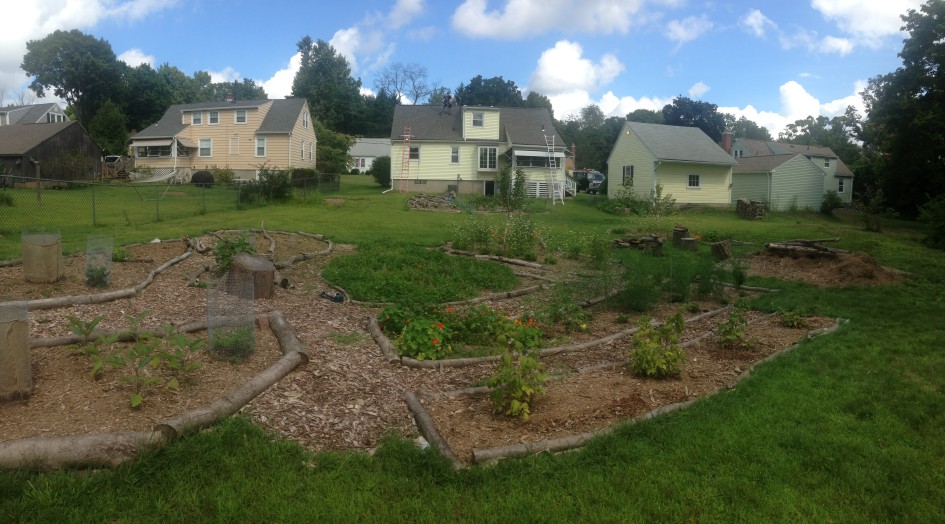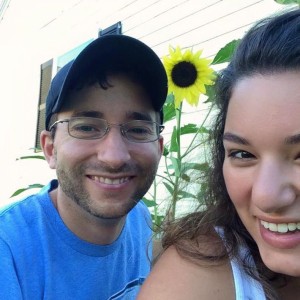Year 1 of the permaculture transition was a full focus on perennial establishment and system building. While year 2 will bring much of the same, we would still like to follow a core tenant of Permaculture: “Obtain a Yield”.
With this in mind we took some steps to harvest in year 1, even if this wasn’t our primary focus. So what I will present here is a summary of the actual harvest we had in year 1. I will also talk about some of the longer term projects we started in hopes for future yields.
Annual Production
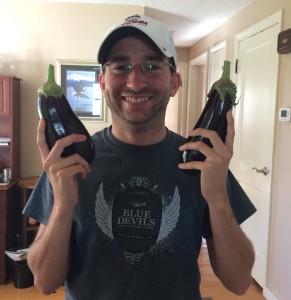
The first eggplant harvest, the excitement is real
Our final count for the 2015 harvest is in, and we harvested 105 lbs of annuals. Using rough market pricing from the farmers market, this is around $220 worth of production. This doesn’t count the handfuls of berries we would pick daily in June, or the herbs, but there wasn’t enough to weigh.
This may not seem like a lot, and it is because we did almost everything wrong (timing, seedlings, watering). To others this may seem like a lot, and to them I say start planting a few easy annuals and they will start paying you back!
Here is a breakdown of the harvest, by estimated value:
- Eggplant: $55 – 22 lbs from 18 eggplants
- Tomatoes: $45 – 15 lbs from 75 tomatoes
- Pumpkin:v$44 – 44 lbs from 4 pumpkins
- Carrots: $37 – 18 lbs from 77 carrots
- Salad Greens: $15 worth of greens and spinach.
- Jalepenos: $14 – 1lb from 28 jalepenos
- Onions: $7 – 5 lbs from 90 onions (they were super tiny, terrible to peal)
- Green Peppers: $5 – 2 lbs from 15 peppers
- Leeks: $2 – 1 lb from 6 Leeks
Herb Garden
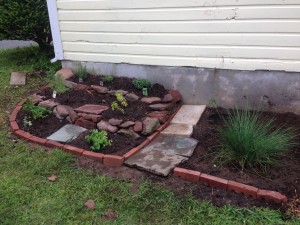 We did not weigh anything coming out of the herb garden, because we usually just harvested fresh from the outside prior to cooking. It is a bit harder to put a monetary value on having fresh herbs minutes away. We were able to plant rosemary, thyme, oregano, dill, basil, parsley, cilantro, chives, and mint. Next year we’ll start early and hope to have fresh herbs all summer. If you want to start anywhere on your own garden, start with herbs!
We did not weigh anything coming out of the herb garden, because we usually just harvested fresh from the outside prior to cooking. It is a bit harder to put a monetary value on having fresh herbs minutes away. We were able to plant rosemary, thyme, oregano, dill, basil, parsley, cilantro, chives, and mint. Next year we’ll start early and hope to have fresh herbs all summer. If you want to start anywhere on your own garden, start with herbs!
We have already introduced you to “Herby” the herb garden, but here he is again. We’re trying to bring some in for the winter like cilantro, basil, lavender, and mint to limited success.
Perennial Establishment
Our most successful venture of 2015 was planting and establishment of our perennials. A tree can be one of the best long term investments, and we have 6 trees, over 25 perennial fruiting bushes, and 14 varieties of leafy perennials.
Our trees are the center of our guilds. We have a Macoun Apple, Honeycrisp Apple, Montmorency Cherry, Stanley Plum, and 2 Pawpaw trees. They will range in size from dwarf 8-10′ to semi-dwarf at 15′. Our food forest might not look like much now, but in a few years the layers will start becoming apparent with the trees taking to the sky.
The perennial shrubs will be the first to start producing, and we even got production this year. We have 4 blueberry bushes, 4 lowbush blueberries, 6 raspberry bushes, strawberry, gooseberry, elderbery, red currants, goji berry, blackberry, kiwi vine, and grapes. We were lucky to have some existing blackberries, a few transplant blueberries, gooseberry, and some fast producing raspberries give us yields in year 1. We were able to have fresh fruits in our morning yogurt for close to 2 months.
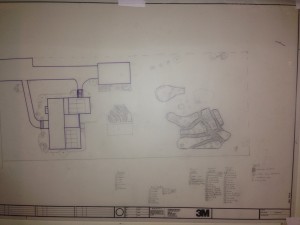
An overhead map of our planting locations and species. It is important to know what was planted where for next spring!
Our perennial leafy plants started as support species for our guilds. These include pollinators, nitrogen fixers, ground covers and accumulators such as yarrow, fennel, artichoke, clover, strawberry. We also started an asparagus patch with 10 plants that look pretty good at the end of year 1. In 2 more years we will be able to start harvesting asparagus. My favorites are the exotic edibles we acquired from the food forest farm in holyoke. These include sorrel, sea kale, sweet cicely, turkish rocket, korean pig plant, mint root, and sunchoke. These are unique flavors that we will be able to incorporate into new and exciting foods.
Soil Building
A big focus of our 2015 efforts will continue to be soil building. Adding organic matter to the soil will make it more productive, help reduce pests, strengthen plants, and also fix carbon from the atmosphere. Bringing in manure, composting, vermicompost and mulching will continue to be staples we will focus on year after year.
In 2016 we plan to start our chickens, continue our perennial food forest, expand our annuals, and keep bringing in new recipes. We appreciate the support, and feedback as we look to expand on a successful year 1 of our suburban permaculture project.
Share Now!
